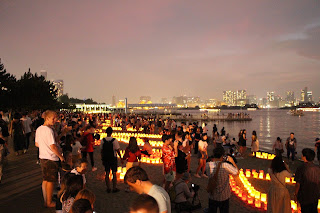Summer weekends in the metropolitan area are busy.
In the occasion of the Marine Day holiday, a nice event was held in Tokyo bay for two consecutive evenings called Umi no Akari Matsuri (海の灯まつり), or seaside lantern festival. In the evening, on both days, something like 20,000 paper lanterns were placed on the beachfront in Odaiba, and were arranged to form several patterns. I hear the patterns were ships, Tokyo sky tree tower, flowers and what not...I only saw hearts, and girls bossing their boyfriends around to take pictures of them sitting inside these heart shapes. Pfff.
Anyway, although the scenic effect of all those lanterns could only be seen from a distance, the atmosphere was nice nonetheless. The area was crowded, the most crowded I've ever seen, with people strolling along the wooden decks, on the sand all around the lanterns, on the pier, everywhere there was a chance to admire the lights.
The darker it got, the better the lanterns looked. I have to say that I totally misunderstood the dynamics of the event. I though, actually, that those lanterns would be let out to float on the water...this is at least what I've seen other times concerning paper lantern (the "toro nagashi" stuff like in HERE), but I guess that with all the evening boat cruises happening around the bay, all the lanterns would be either overshadowed by the brightly and colorfully lit boats or simply capsized. One thing sure enough, those who had planned a boat tour of the bay did the best thing, as they had the best view of the lanterns.
Too bad there is only one tiny cafe (and has a terrace!) on the beach, cause I'd have loved to take a seat and enjoy some cold drinks while people-watching. It was crowded, of course and didn’t want to wait ages. Anyway it would have been impossible to find a seat there, unless one booked weeks in advance, as I am sure many did. On the other hand, though, most people were there to simply take the sunset view in, wait for the lights to shine, take their picture and go, not even enjoy a refreshing drink for some time. Perhaps a lot of them didn’t even know about the lanterns and went to the bay just to check out the city view (tourists, for instance).
Fortunately some gentle breeze was cooling us down by the bay (we've been cooked by a 10-days heat wave that doesn't give any signs of leaving soon), so it was indeed nice to be there in the evening. A sunset swim would have been the best way to fully enjoy the occasion, but, heh, no swimming in the polluted waters of Tokyo bay, thanks.
*************
I fine settimana estivi dell’area metropolitana sono impegnatissimi.
In occasione della festività nota come giorno del mare, si e’ tenuto un bell’evento alla baia di Tokyo che e’ durato due giorni e si chiama Umi no Akari Matsuri (海の灯まつり), ovvero festa delle lanterne. Alla sera, entrambi i giorni, circa 20mila lanterne di carta sono state disposte sulla spiaggia di Odaiba, organizzate in modo da formare diversi oggetti. Pare che tra i vari disegni fossero barche, la torre di Tokyo e altro ancora…io ho solo visto cuori, e ragazze che forzavano i fidanzati a farsi fare fotografie sedute all’interno di sti cuori. Va beh.
Comunque, anche se l’effetto scenografico delle lanterne si poteva carpire solo da una certa distanza, l’atmosfera generale non era male. La spiaggia era piena di gente, come mai vista prima, e c’era chi passeggiava lungo la strada, chi sulla spiaggia, chi si intratteneva tra le lanterne, insomma ovunque si potevano ammirare le lucine c’era gente.
Poi, più si faceva buio e meglio si vedevano le lanterne. Devo pero’ dire che avevo completamente frainteso le dinamiche dell’evento. Infatti pensavo che le lanterne venissero lasciate galleggiare sull’acqua…per lo meno, questo e’ ciò che ho sempre visto quando si trattava di lanterne (tipo le “toro nagashi” qui), ma mi sa che data la presenza di battelli per le crociere intorno alla baia ste povere lanterne verrebbero o oscurate dalle luci delle barche oppure affondate. Certo e’ che quelli che hanno ben pensato di osservare le lanterne dal mare hanno fatto la scelta migliore.
Peccato che ci sia solo un piccolo bar (che tra l’altro ha pure la terrazza!) sulla spiaggia, perché mi sarebbe proprio piaciuto prendere posto e godermi una bibita fresca mentre osservavo i passanti. Ovviamente il bar era pieno e non mi andava di aspettare a lungo. In ogni caso mi sa che sarebbe stato comunque impossibile trovare un tavolo, a meno che uno avesse prenotato con settimane di anticipo, cosa che sono sicura molti hanno fatto. Di fatto pero’ la maggior parte delle persone che si trovavano li erano di passaggio, giusto per aspettare che le lanterne venissero accese, fare la loro foto e andare. Forse pure una buona parte di essi non sapevano neanche della cosa e si trovavano li per puro caso (tipo, turisti).
Fortune ha voluto che ci fosse un’arietta fresca alla baia quella sera (siamo vittime di una ondata di caldo che non ci da tregua da quasi due settimane), quindi e’ stato proprio rinvigorente trovarsi li. Certo, una nuotata dopo il tramonto sarebbe stata la giusta cosa da fare, ma immergermi nelle acque inquinate della baia di Tokyo non mi pareva proprio il caso.




